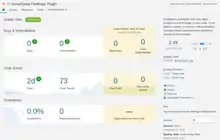SonarQube
SonarQube (formerly Sonar)[3] is an open-source platform developed by SonarSource for continuous inspection of code quality to perform automatic reviews with static analysis of code to detect bugs and code smells on 29 programming languages. SonarQube offers reports on duplicated code, coding standards, unit tests, code coverage, code complexity, comments, bugs, and security recommendations.[4][5]
 A SonarQube project homepage | |
| Developer(s) | SonarSource |
|---|---|
| Initial release | 2006–2007[1] |
| Stable release | 9.9
/ February 7, 2023[2] |
| Repository | |
| Written in | Java |
| Operating system | Cross-platform |
| Type | Static program analysis |
| License | Lesser GNU General Public License |
| Website | sonarqube |
SonarQube provides fully automated analysis and integration with Maven, Ant, Gradle, MSBuild and continuous integration tools (Atlassian Bamboo, Jenkins, Hudson, etc.).[6][7]
Overview
SonarQube supports the programming languages Java (including Android), C#, C, C++, JavaScript, TypeScript, Python, Go, Swift, COBOL, Apex, PHP, Kotlin, Ruby, Scala, HTML, CSS, ABAP, Flex, Objective-C, PL/I, PL/SQL, RPG, T-SQL, VB.NET, VB6, and XML.[9] As of December 2021, analyzing C, C++, Obj-C, Swift, ABAP, T-SQL, and PL/SQL is only available via a commercial license.
SonarQube is available for free under the GNU Lesser General Public License. An enterprise version for paid licensing also exists, as well as a data center edition that supports high availability.[10][11]
SonarLint
SonarQube is expandable with the use of plug-ins. It integrates with the Eclipse, Visual Studio, Visual Studio Code, and IntelliJ IDEA development environments through SonarLint plug-ins, as well as external tools such as LDAP, Active Directory, and GitHub.[12][13]
Reception
In 2009, SonarQube received a Jolt Award under the testing tools category.[14][15]
References
- "History | SonarSource". www.sonarsource.com.
- "What's New in latest releases | SonarQube". www.sonarqube.org.
- Freddy Mallet (20 March 2013). "SONAR is becoming SONARQUBE". SonarQube project mailing list. Archived from the original on 24 July 2013. Retrieved 3 July 2013.
- "Sonar" (PDF). Methods and Tools. Vol. 18, no. 1. 2010-03-01. pp. 40–46. ISSN 1661-402X. Retrieved 2017-08-29.
- Campell/Papapetrou, Ann/Patroklos (2013). Sonar (SonarQube) in action. Greenwich, Connecticut, USA: Manning Publications. p. 350. ISBN 978-1617290954.
- Buijze, Allard (2010-02-26). "Measuring Code Quality With Sonar". Archived from the original on 2011-08-12. Retrieved 2017-08-29.
- Odendaal, René (2009-06-24). "Continuous Integration on SAP using Subversion, Maven, Hudson, Nexus and Sonar". Archived from the original on 2012-07-24. Retrieved 2017-08-29.
- "Multi-Language | SonarQube". Retrieved 2021-01-25.
- "License | SonarQube". www.sonarqube.org. Retrieved 2018-03-28.
- "Plans & Pricing | SonarSource". www.sonarsource.com. Retrieved 2018-03-28.
- Mariano (2009-11-17). "Creating a Sonar Plugin for software development metrics". Archived from the original on March 24, 2010. Retrieved 2017-08-29.
- Hazrati, Vikas (2010-03-30). "Monetizing the Technical Debt". Retrieved 2017-08-29.
- "Jolt Awards Winners". 2009-03-18. Archived from the original on February 1, 2010. Retrieved 2010-04-13.
- "Jolt Productivity Award #2: Testing and Debugging". 2010-12-01. Retrieved 2010-12-09.